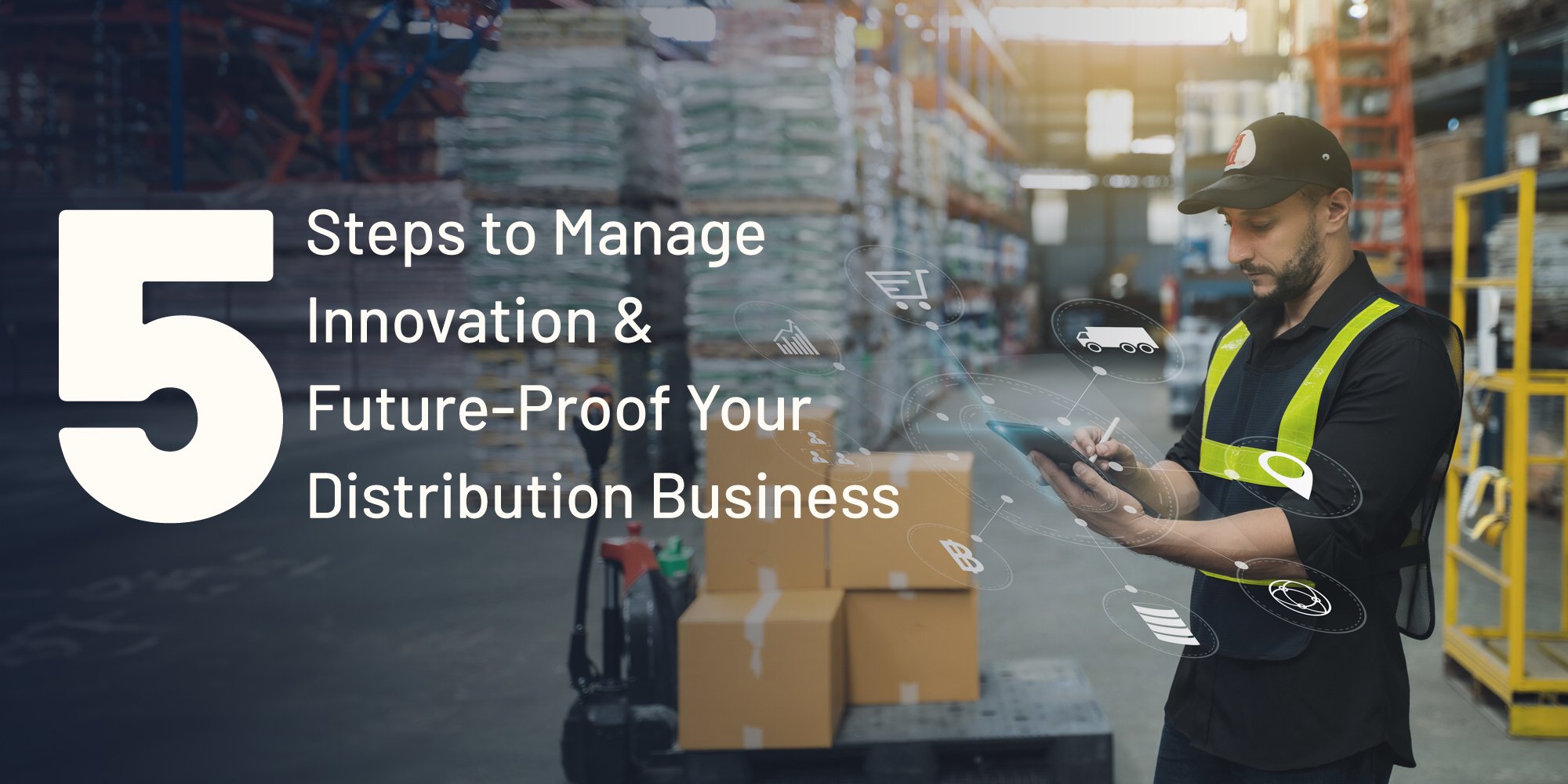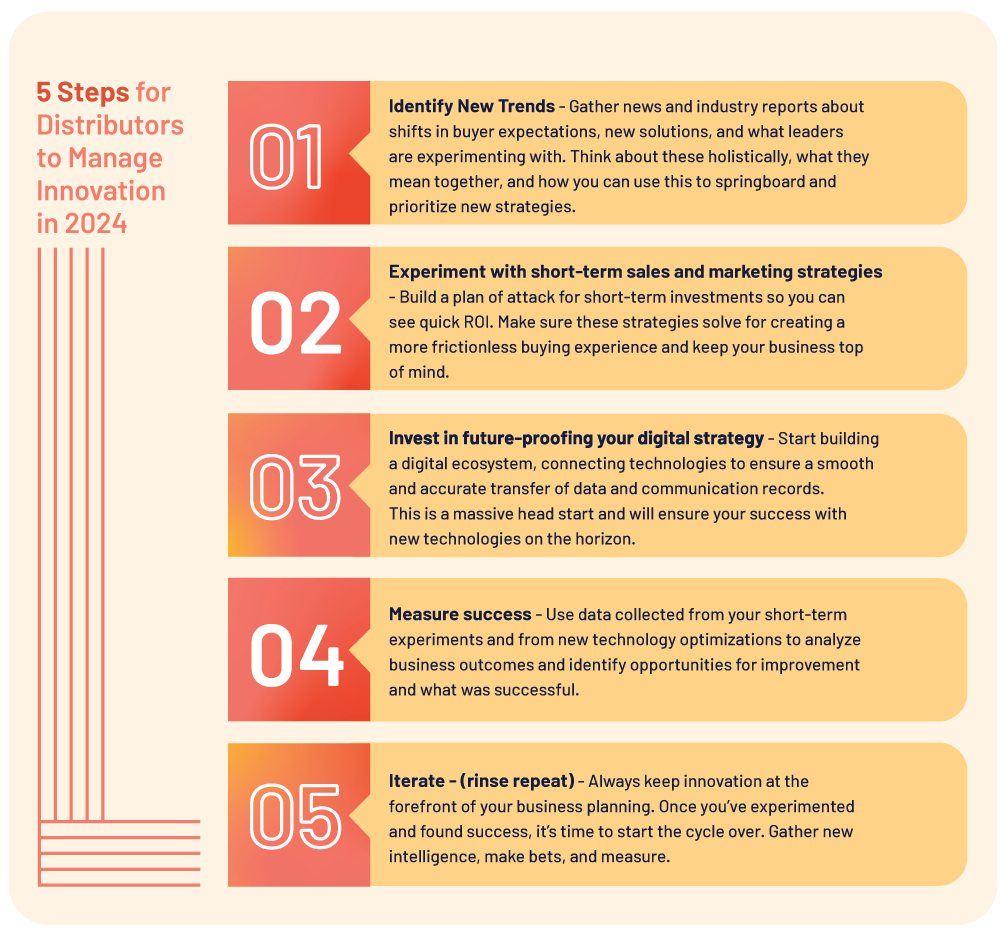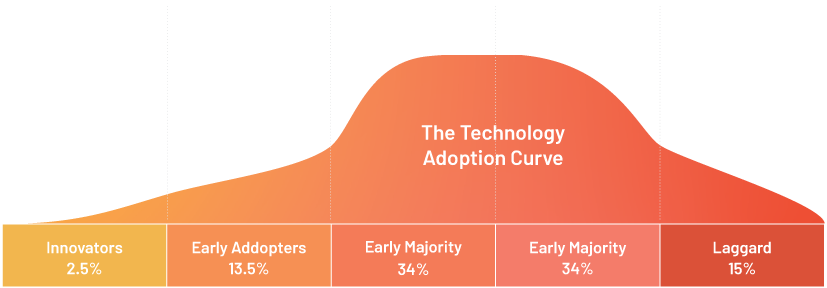
5 Steps to Manage Innovation & Future-Proof Your Distribution Business

If you want to succeed now, you need innovation. A pressing need for speed and efficiency has brought on higher stakes for distributors, and while it was once enough to react to changes around you, today, that is a recipe for falling behind.
Innovators in distribution see EBITDA margin growth 2.6x higher than distributors that classify as Growth Performers and more than 8x higher than Underperformers. - McKinsey & Company, 2023
Innovation sets you apart and empowers you to provide your customers with new and improved experiences. Being an innovator means your business creates new standards rather than following them.
The Need for Future-Proofing in a Dynamic Market
Today’s distribution market is more dynamic than ever — from tougher competition to higher customer expectations, successful distributors today are constantly evolving and looking for ways to provide a frictionless customer experience.
This means you must take steps to protect your future to stay competitive. Successful distributors prioritize innovation and invest in new strategies — if you’re not doing this, you’re setting yourself back.
Think about Blockbuster. When Netflix began pioneering new ways of serving customers movie rentals, Blockbuster refused to embrace change and kept operating business-as-usual — until 2014, when they closed every door and became a notion of the past. Today, as the movie market evolves and becomes even more dynamic, Netflix continues to innovate and change, and that’s why it’s still leading the market and not following Blockbuster’s footsteps.
But you can’t just jump into change haphazardly. You need a plan.
Want to skip to the good stuff? Download our 25 Innovations Handbook Here
How Strategic Change Management Increases ROI
84% of executives point to innovation as the key to their growth, and US businesses aren’t slow to start, with $538 B spent on innovation just in 2020.
But managing change is risky — with a new product failure rate of around 40%, dollars lost in innovation expenses totaled $215 billion in recent years. Without a plan, change management outcomes miss goal expectations 50% of the time. That’s why you need to have a plan before diving head-on into a new innovation.
These risks shouldn’t stop you from growing. You can take steps to implement change while mitigating threats to your organization. This way, you can invest in the future without fear of failure.
We compiled five steps to successfully execute, manage, and iterate any innovation. With these, you'll take on challenges effectively and set yourself up for continuous improvement.

Step 1: Identify New Trends
First, identify and study trends currently on the market. Thinking about these holistically helps you develop your vision and pinpoint opportunities for new solutions. Always stay up-to-date, gathering news and industry reports on shifts in buyer expectations, new solutions, and what leaders are experimenting with.
Benefits of studying and understanding market trends include:
| 1. | Knowing Consumer Behavior: Understanding trends allows you to anticipate changes in consumer preferences, buying habits, and market demands. Knowing consumer behavior helps you tailor products, services, and more. |
| 2. | Building a Competitive Advantage: By staying aware of industry patterns, you’ll better understand what your competitors are doing and can better differentiate yourself in strategy and the market. |
| 3. | Mitigating Risks: Being aware of movements in the industry allows you to identify potential risks and challenges early on. This way, you can effectively reduce uncertainty. |
| 4. | Identifying Opportunities: Trends present new opportunities for business growth and expansion. Recognizing and capitalizing on patterns allows you to explore new markets, develop different products or services, and diversify revenue streams. |
| 5. | Empowering Strategic Decision-Making: Knowing trends gives you insight for more strategic decision-making. Market tendencies can inform business planning, resource allocation, and investment decisions and build better long-term goals. |
| 6. | Customer Engagement: Keeping up with trends allows you to stay relevant and engage your target audience. You'll meet current customer expectations by aligning offerings and messaging with existing industry patterns. |
Trends provide insight into the industry, where it currently stands, and where it’s likely to go. Subscribe to podcasts and newsletters, and engage with industry-thought leaders to grow your knowledge.
Some great examples of industry thought leaders include:
- Modern Distribution Management (MDM)
- Distribution Strategy Group (DSG)
- ConstructionDive
- Industrial Distribution
- Mckinsey & Company
- Construo News Digest
Be sure to pay special attention to trends in customer feedback and preferences. Distribution hinges on relationships; being aware of customer trends enables you to make informed decisions and provide a frictionless experience. Strong practices for measuring customer preferences in addition to your independent market research include:
- Analyzing Sales Data
- Monitoring Website and App Analytics
- Collecting Customer Feedback through NPS surveys and more
- Investing in data analytics to pull better insights
With a better understanding of what’s going on in your industry, you can make educated decisions on what’s expected of you and where to take your business. This way, you won’t make changes blindly; every decision is driven by intention.
Step 2: Experiment with Short-Term Sales and Marketing Strategies
Once you’ve established a habit of identifying and studying trends, the next step is to experiment with short-term sales and marketing strategies. Sales and marketing generate revenue, build awareness, build better relationships, and more.
Businesses with strong sales and marketing strategies and alignment between the two are 67% more effective at closing deals and 58% better at retaining customers. It's clear that effective, integrated strategies, paired with a well-adapted team, are powerful tools for boosting profits and chasing every last avenue for business.
 Despite so much potential for driving growth, only 63% of distributors invest in marketing efforts, and ⅓ see a positive impact from marketing. This means sales and marketing are huge opportunities — by investing in them, you’ll set yourself wildly ahead.
Despite so much potential for driving growth, only 63% of distributors invest in marketing efforts, and ⅓ see a positive impact from marketing. This means sales and marketing are huge opportunities — by investing in them, you’ll set yourself wildly ahead.
 Significant shifts can be cumbersome. On one hand, you have long-term investments that are quite the organizational lift; on the other, you have your quick wins. These short-term strategies can be implemented with little effort/risk and offer a quick ROI. Here are some steps to start small:
Significant shifts can be cumbersome. On one hand, you have long-term investments that are quite the organizational lift; on the other, you have your quick wins. These short-term strategies can be implemented with little effort/risk and offer a quick ROI. Here are some steps to start small:
| 1. | Find new ways to engage with customers: Sales and marketing rely on customer relationships and interactions, and you can start by finding new ways to engage with customers. This allows you to adapt to changes in preferences and reach them from different avenues. New touchpoints with customers are new ways you can market to them. |
| 2. | Identify tactics that create a more frictionless buying experience: Today, speed is critical. Contractors have more weight on their shoulders and need to do business fast so they can get back to their own. Once you’ve found new ways to engage with customers, think about which will create a frictionless experience for them. An example of this is SMS marketing, handing them offers right from their mobile phones — so they can engage without stopping what they’re doing. |
| 3. | Build a plan of short-term investments: Once you’ve settled on which innovations to implement in the short term, build your plan of attack. Start by defining goals, assessing your risk tolerance, and then creating a time frame, all while keeping informed of industry trends. |
| 4. | Test your investments: After you’ve kicked off your short-term strategies, a great way to test their effectiveness is A/B testing — a methodology used to compare two versions of a marketing asset to find which one performs better. Split your customers into groups based on personas and test which strategy works better. |
You’ll set yourself ahead by prioritizing your sales and marketing strategies. Starting small with short-term investments and using this model for identifying, planning, and launching new tactics allows you to see ROI faster with a lower risk.
Step 3: Invest in Future-Proofing Your Digital Strategy
According to Forbes, 56% of CEOs say digital transformation has increased revenue and fostered benefits like better operational efficiency, faster time to market, and the ability to meet customer expectations.
Building a digital strategy aims to give your customers a frictionless buying experience and make doing business easier. On the outside, customers will have more seamless ways to engage with you; on the inside, technology will streamline your processes and allow you to get work done faster. If your work is efficient, your service is efficient.
The time to get started is now. Frictionless service is no longer a luxury but an expectation. And today, it takes more than siloed technology — you need a digital ecosystem.

A digital ecosystem is an interconnected network of digital platforms, services, technologies, and stakeholders working together. It ties together all your digital tools, including software applications, hardware devices, data sources, networks, and users, empowering you to work efficiently and deliver that frictionless experience. Digital ecosystems promote smooth and accurate data transfer and are a massive head start in differentiating yourself from competitors.
Key components of a digital ecosystem include:
| 1. | Platforms and Infrastructure: These are the foundation of the digital ecosystem, the technologies that enable digital interactions and transactions to take place. Some examples are ERPs, cloud computing platforms, operating systems, communication platforms, and more. |
| 2. | Application Programming Interface (API): APIs allow different software applications to communicate and interact with each other. This involves different systems, applications, and devices all working together to communicate and share data. With an API, you eliminate steps like manually updating different systems, ensure data is consistent across platforms, and work more efficiently. |
| 3. | Data Sources and Analytics: Data drives insights, personalization, and decision-making and is critical in your digital ecosystem. Data sources include user-generated data, sensor data, transactional data, and more. You can use analytics tools to collect, process, and analyze data and, with it, take insights to inform your decisions. |
| 4. | Automation: Automation enables repetitive tasks, workflows, and processes to happen instantly. Data entry, document processing, inventory management, customer support, and more can all be automated. This way, you'll streamline operations and work more efficiently. |
| 5. | AI: AI has a lot of capabilities, like processing and interpreting complex data sets, creating forecasts based on data, delivering personalized experiences to customers based on past interactions, and more. AI promotes speed and accuracy and allows you to understand your organization's status better. |
With your digital ecosystem, you’ll work faster, provide that frictionless experience, and continue to manage change effectively with every innovation. Not only will this aid you in taking on new challenges, but it will also make fulfilling tasks and serving customers quick, easy, and accurate.
Step 4: Measuring Success
As you innovate, you must constantly measure success to determine what’s worth your investment and what isn’t. Measuring success allows you to assess ROI, keep aligned with goals, make informed decisions, and continually adapt to change.
Key Performance Indicators (KPIs) are a powerful tool for measuring success. These are metrics to evaluate and track progress toward goals and objectives. They can be financial, operational, or centered around customers and employees. Some great areas to set KPIs around include:
Sales Metrics
Sales are the foundation of your business’s profitability, and KPIs around sales metrics evaluate sales performance and help you drive improvement. Some common ones are:
| 1. | Sales Revenue: The total revenue generated from sales within a specific period, for example, monthly, quarterly, or annually. Sales revenue gives you an overall measure of sales performance and revenue growth. |
| 2. | Sales Growth Rate: The percentage increase or decrease in sales revenue compared to the previous period. Sales growth rate tells you the rate of expansion or contraction in sales over time. |
| 3. | Sales Pipeline Value: The total value of all opportunities and deals in the sales pipeline. Sales pipeline value helps you forecast future revenue and determine the health of your pipeline. |
| 4. | Opportunity Win Rate: The percentage of leads successfully closed; this measures the effectiveness of your sales team. |
| 5. | Average Order Value (AOV): The average value of individual orders or transactions. AOV helps you forecast profits and identify opportunities to increase revenue. |
| 6. | Sales Cycle Length: The average time it takes to close a deal from the initial contact to the final sale. A shorter sales cycle is reflective of a more efficient team. |
| 7. | Customer Acquisition Cost (CAC): The average cost of acquiring a new customer, including sales and marketing expenses. This tells you the potential profitability of customer acquisition efforts. |
| 8. | Customer Lifetime Value (CLV): The total value a customer is expected to generate over their entire relationship with the company. CLV helps you prioritize sales efforts. |
| 9. | Sales Rep Performance: Individual sales representatives' performance metrics, for example, total sales revenue, conversion rates, pipeline value, and activity levels. This way, you can identify top performers and coach those who need it. |
| 10. | Sales Activity Metrics: Metrics like the number of calls made, emails sent, meetings held, and proposals submitted. Sales activity metrics allow you to assess sales productivity and identify areas for improvement. |
Customer Engagement Metrics
KPIs around customer engagement help you assess customer satisfaction, specifically their level of interaction with your business. Some great ones to set include:
| 1. | Website Traffic: The number of visitors to the company's website over a specific period, measuring brand awareness and your engagement online. |
| 2. | Page Views: The number of pages viewed by visitors on the website, reflecting engagement in the content on your website. |
| 3. | Conversion Rate: The percentage of website visitors who purchase, sign up for a newsletter, or download a resource, reflecting the effectiveness of your marketing efforts. |
| 4. | Customer Retention Rate: The percentage of customers who continue to spend over time, measuring customer loyalty and the effectiveness of any customer retention efforts. |
| 5. | Customer Satisfaction Score (CSAT): A metric used to measure customer satisfaction based on direct customer feedback, telling you the overall satisfaction level with products, services, or other company interactions. |
| 6. | Net Promoter Score (NPS): A metric that measures customer loyalty based on the likelihood of customers recommending the company to others, showing your customer satisfaction level. |
| 7. | Customer Referral Rate: The percentage of customers who refer new ones through word-of-mouth or referral programs measuring customer satisfaction and willingness to advocate for your business. |
| 8. | Customer Education and Training Metrics: Metrics related to customer education and training programs the company offers, such as course completion rates, quiz scores, and certification achievements. Offering education opportunities is a great way to build brand awareness and relationships, and this metric measures the effectiveness of these efforts. |
| 9. | Customer Feedback and Reviews: Metrics related to customer feedback and reviews, such as ratings, testimonials, and surveys, give you insights into customer satisfaction. |
| 10. | Community Engagement Metrics: Metrics around engagement within online spaces like social media, your website, reviews, or other online discussions tell you the level of engagement beyond just in the branch. |
These are just a few solid examples. Tracking and analyzing KPIs help you understand your sales performance, customer satisfaction, and overall organization status. As you continue to innovate, your KPIs will guide your decisions — highlighting successes, shedding light on areas of improvement, and helping you pinpoint what to pursue next.
Step 5: Iterate & Repeat
Managing change is no easy feat, but you shouldn’t let fear stifle your growth opportunities. By effectively planning and building an environment where change is valued, you’ll iterate and repeat this process — so innovation will become just a natural aspect of doing business. Don’t stop with minor changes; don’t be afraid to make shifts if your metrics indicate you should do so.
By focusing on innovation and building a culture that adapts well to it, you’ll equip your team with more tools to jump on new changes in the future. And you can keep your momentum up by constantly looking for more opportunities as you go. Some critical practices to keep your business evolving include:
| 1. | Learning from Failures: failing is a natural part of the learning process, and with the right attitude, it can be a powerful opportunity for improvement. Fail fast and move forward by assessing what went wrong, taking quick, corrective measures, and looking at failures as opportunities for learning rather than complete and utter defeats. |
| 2. | Keeping Agile: Agility allows you to respond quickly and adapt to changing market conditions, move on from failures, and keep chasing after new goals. Always continue your market research, encourage learning, and move on from failures to keep a flexible culture. |
| 3. | Staying Open to Change: By staying open to change, you’ll adapt more effectively to trends in the industry, be better prepared to jump on opportunities and chase more avenues for growth and innovation. Be willing to pivot, adjust plans, and reallocate resources as needed. This helps you continue to foster innovation as you grow and learn. |
| 4. | Embracing an Iterative Mindset: An iterative mindset is a way of thinking and working that values continuous improvement and learning through experimentation and feedback. An iterative mindset promotes your culture of innovation and empowers you to embrace uncertainty. |
Continuous improvement drives innovation. Your journey doesn’t stop with learning to stay informed, adopting short-term strategies, or digitizing. By adopting a mindset and practice of constant evolution, you’ll only propel your business forward and power more innovation every step of the way.
Conclusion
Innovation is key to success in distribution today. With a proper implementation plan, it can be an exciting process without all the risks that usually discourage distributors from taking leaps.
By identifying new trends, experimenting with short-term sales and marketing strategies, investing in your digital strategy, measuring success, and finally iterating and repeating, you’ll build a model that effectively manages innovation and future-proof your distribution business with every new endeavor.
While you pave the way for continuous growth, look for strategies that best suit your organization’s needs, like partnering with technologies that empower innovation.
Prokeep: the All-Encompassing Key to Distributor Success
For a full-fledged solution to power constant evolution tailored to distributor needs, innovators are turning to Prokeep to boost sales and efficiency through communication.
Prokeep is a communication platform tailored to distributors that connect text, email, and fax into one easy-to-access workspace. With Prokeep, your team can connect with customers, answer inquiries, and make sales, all with the press of a button. Prokeep’s easy-to-use avenues for better marketing, sales enablement, and communication drive innovation while fostering your digital ecosystem. These capabilities include:
| 1. | Seamless SMS: From the counter computer or mobile app, reps can send and receive text messages to customers' mobile phones with just the press of a button. This way, they can close deals, answer questions, and provide expert advice while attending to customers in stores or talking to someone else on the phone. |
| 2. | Broadcast Messaging - Prokeep’s broadcast messaging capability enables you to send mass promotions to custom lists, creating more opportunities to upsell and engage with customers. And unlike other broadcast marketing efforts, customers are instantly connected to a counter rep when they respond to a message. This empowers you to market effectively and sets your business apart from others who do the same. |
| 3. | Accessible Customer Information: Prokeep stores all customer information and conversation history within its dashboard, empowering tactical re-engagement. By quickly looking through past interactions, you can suggest other add-ons or inquire about previous purchases to continue to drive business with current customers. |
| 4. | Relationship Intelligence: Besides its communication solution, Prokeep’s CRM empowers you to leverage customer data to optimize sales processes, keep accurate records, and personalize your marketing efforts to your customers. This way, your every touch point with customers is informed and tailored to their needs. |
| 5. | Connected Technologies: Prokeep’s API feature connects to your ERP, CRM, logistics software, and more. With options like contact syncs, automated order updates, and custom integrations available, ensure your ecosystem is seamless and up-to-date. This eliminates errors and empowers you to serve customers instantly. |
| 6. | Better Visibility: With shared email, branch texting, and internal messaging, any team member can access conversations and better collaborate to serve customers. Do you have employees on vacation? By scrolling through past interactions, anyone can understand what a customer needs. No more silos, and no more making the customer reiterate. |
With Prokeep, distributors are spearheading growth and changing how they do business. Through frictionless conversations with just the touch of a button, Prokeep empowers innovation and paves the way for success.
Do you want to innovate with Prokeep’s unique solutions? Let’s get in touch.




